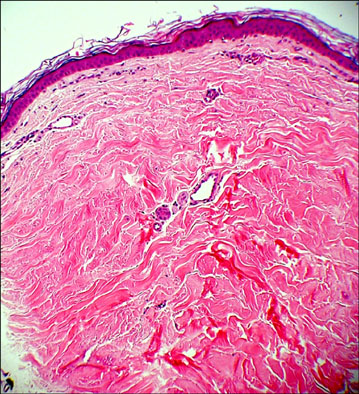Ann Dermatol.
2011 May;23(2):242-245. 10.5021/ad.2011.23.2.242.
Morphea Developing at the Site of Healed Herpes Zoster
- Affiliations
-
- 1Department of Dermatology, Sanggye Paik Hospital, Inje University College of Medicine, Seoul, Korea. gsjfirst@empal.com
- KMID: 2156674
- DOI: http://doi.org/10.5021/ad.2011.23.2.242
Abstract
- Wolf's isotopic response describes the occurrence of a new, unrelated disease that appears at the same location as a previously healed skin disease, and the most common primary skin disease of this phenomenon is herpes zoster. Several cutaneous lesions have been described to occur at the site of healed herpes zoster, and granulomatous dermatitis and granuloma annulare have been reported to be the most common second diseases. The pathogenesis of the isotopic response is still unclear. Morphea can develop at the site of regressed herpes zoster and a few such cases have been reported. We present here an additional case of morphea that developed at the site of previously healed herpes zoster, and we review the relevant literature.
Keyword
Figure
Cited by 1 articles
-
A Case of Wolf's Isotopic Response Presenting as Bullous Pemphigoid
Seung Hyun Chun, Bo Young Kim, Chang Min Kim, Jae Beom Park, Hwa Jung Ryu
Ann Dermatol. 2017;29(4):499-500. doi: 10.5021/ad.2017.29.4.499.
Reference
-
1. Requena L, Kutzner H, Escalonilla P, Ortiz S, Schaller J, Rohwedder A. Cutaneous reactions at sites of herpes zoster scars: an expanded spectrum. Br J Dermatol. 1998. 138:161–168.
Article2. Ruocco V, Ruocco E, Ghersetich I, Bianchi B, Lotti T. Isotopic response after herpesvirus infection: an update. J Am Acad Dermatol. 2002. 46:90–94.
Article3. Wolf R, Brenner S, Ruocco V, Filioli FG. Isotopic response. Int J Dermatol. 1995. 34:341–348.
Article4. Zimmermann H. Zoster as a premorbid state of a circumscribed scleroderma. Dermatol Wochenschr. 1964. 150:112–116.5. Forschner A, Metzler G, Rassner G, Fierlbeck G. Morphea with features of lichen sclerosus et atrophicus at the site of a herpes zoster scar: another case of an isotopic response. Int J Dermatol. 2005. 44:524–525.
Article6. López N, Alcaraz I, Cid-Mañas J, Camacho E, Herrera-Acosta E, Matilla A, et al. Wolf\'s isotopic response: zosteriform morphea appearing at the site of healed herpes zoster in a HIV patient. J Eur Acad Dermatol Venereol. 2009. 23:90–92.
Article7. Serfling U, Penneys NS, Zhu WY, Sisto M, Leonardi C. Varicella-zoster virus DNA in granulomatous skin lesions following herpes zoster. A study by the polymerase chain reaction. J Cutan Pathol. 1993. 20:28–33.
Article8. Claudy AL, Chignol MC, Chardonnet Y. Detection of herpes simplex virus DNA in a cutaneous squamous cell carcinoma by in situ hybridization. Arch Dermatol Res. 1989. 281:333–335.
Article9. Lotti T, Hautmann G, Panconesi E. Neuropeptides in skin. J Am Acad Dermatol. 1995. 33:482–496.
Article10. Vancheeswaran R, Black CM, David J, Hasson N, Harper J, Atherton D, et al. Childhood-onset scleroderma: is it different from adult-onset disease. Arthritis Rheum. 1996. 39:1041–1049.
Article11. Aberer E, Neumann R, Stanek G. Is localised scleroderma a Borrelia infection? Lancet. 1985. 2:278.
Article12. Hasegawa M, Sato S, Nagaoka T, Fujimoto M, Takehara K. Serum levels of tumor necrosis factor and interleukin-13 are elevated in patients with localized scleroderma. Dermatology. 2003. 207:141–147.
Article13. Sedgwick JD, Riminton DS, Cyster JG, Körner H. Tumor necrosis factor: a master-regulator of leukocyte movement. Immunol Today. 2000. 21:110–113.
Article14. Zurawski G, de Vries JE. Interleukin 13, an interleukin 4-like cytokine that acts on monocytes and B cells, but not on T cells. Immunol Today. 1994. 15:19–26.
Article15. Burd PR, Thompson WC, Max EE, Mills FC. Activated mast cells produce interleukin 13. J Exp Med. 1995. 181:1373–1380.
Article16. Peterson LS, Nelson AM, Su WP. Classification of morphea (localized scleroderma). Mayo Clin Proc. 1995. 70:1068–1076.
Article17. Joly P, Bamberger N, Crickx B, Belaich S. Treatment of severe forms of localized scleroderma with oral corticosteroids: follow-up study on 17 patients. Arch Dermatol. 1994. 130:663–664.
Article18. Elst EF, Van Suijlekom-Smit LW, Oranje AP. Treatment of linear scleroderma with oral 1,25-dihydroxyvitamin D3 (calcitriol) in seven children. Pediatr Dermatol. 1999. 16:53–58.
Article19. Mancuso G, Berdondini RM. Localized scleroderma: response to occlusive treatment with tacrolimus ointment. Br J Dermatol. 2005. 152:180–182.
Article20. Dytoc M, Ting PT, Man J, Sawyer D, Fiorillo L. First case series on the use of imiquimod for morphoea. Br J Dermatol. 2005. 153:815–820.
Article21. Grundmann-Kollmann M, Ochsendorf F, Zollner TM, Spieth K, Sachsenberg-Studer E, Kaufmann R, et al. PUVA-cream photochemotherapy for the treatment of localized scleroderma. J Am Acad Dermatol. 2000. 43:675–678.
Article22. El-Mofty M, Zaher H, Bosseila M, Yousef R, Saad B. Low-dose broad-band UVA in morphea using a new method for evaluation. Photodermatol Photoimmunol Photomed. 2000. 16:43–49.
Article23. El-Mofty M, Mostafa W, El-Darouty M, Bosseila M, Nada H, Yousef R, et al. Different low doses of broad-band UVA in the treatment of morphea and systemic sclerosis. Photodermatol Photoimmunol Photomed. 2004. 20:148–156.
Article
- Full Text Links
- Actions
-
Cited
- CITED
-
- Close
- Share
- Similar articles
-
- A Case of Verrucous Hyperplasia at the Site of Healed Herpes Zoster: Isotopic Response
- A Case of Acneiform Eruption on the Healed Site of Herpes Zoster
- Two Cases of Chronic Cutaneous Graft-versus-host-reaction on the Site of Healed Herpes Zoster as an Isotopic Response
- Reactive Perforating Collagenosis Arising at the Site of Healed Herpes Zoster
- A Case of Zosteriform Lichen Planus on the Site of Healed Herpes Zoster: Wolf's Isotopic Response



